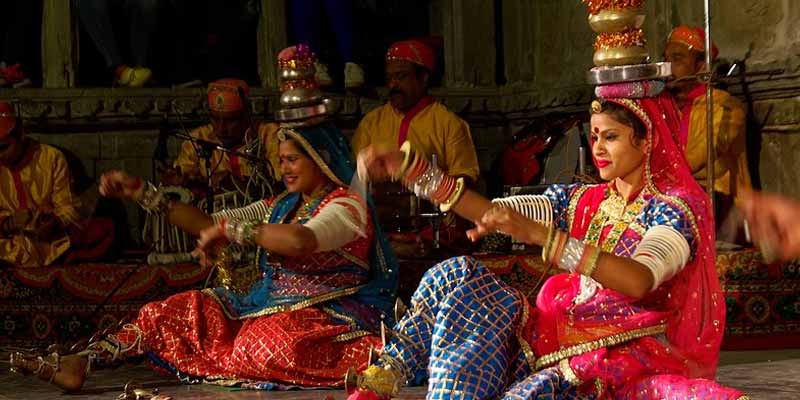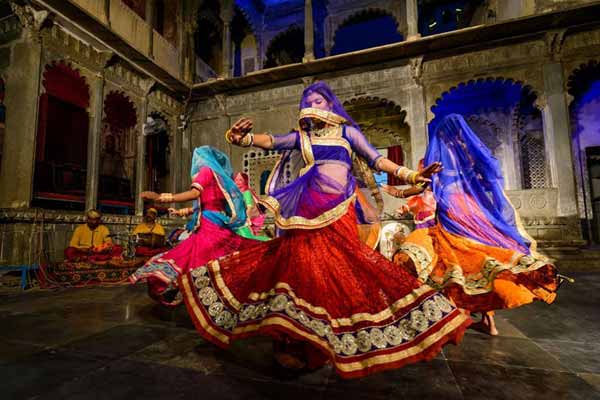Ghoomar Dance Folk Dance of Rajasthan, performed by the women folk who are clad in veils and flowing dresses called “ghaghra”. It was ranked 4th in the list of “Top 10 local dances around the world” The word ghoomna describes the twirling movement of the dancers and is the basis of the word Ghoomar Dance Folk Dance of Rajasthan.
Chari dance is prominent amonst Gujjar and Saini community of Kishangarh and Ajmer in Rajasthan. Chari dance is a female group dance and is performed at marriage celebrations, on the birth of a male child and during festivals. Dancers carry flaming pots on their heads, without giving any support with their hands, while performing graceful movements with their limbs and hips.
Chakri Dance is performed in almost all the marriages and festivals in the Haroti region of Rajasthan. Chakri translates to “Chakkar” in Hindi and Circle in English, and the highlight of the dance is the circular motion of the dancers sitting on their knees, twirling round and round in circles, with their skirts in constant flare to the rhythmic beats of the “Nagara”.
The popular folk song, “Pallo Lat Ke”, depicts the emotional disputes between the bride and the bridegroom, during the occasion of their wedding, Ghoomar Dance Folk Dance of Rajasthan.
Kalbelia or Kabeliya is one of the most famous dance forms of Rajasthan, performed by a tribe of the same name. The Kalbeliya tribes are nomads and are traditional serpent charmers. Hence, the dance movements and the costumes bear a resemblance to that of the serpents. Both men and women participate in the dance.
Holiya Me Ude Re Gulal… is a Rajasthani folk dance that exalts the celebration of the Indian festival of colours, Holi.
Tarazu symbolises the equilibrium that the people of Rajasthan maintain in all aspects of their life. Be it the sun baked sands of the desert or the coolness inside the mud huts, the people of Rajasthan does a balancing act, which strikes a harmonious blend with Mother Nature, Ghoomar Dance Folk Dance of Rajasthan.

What is Ghoomar Dance?
Ghoomar is a traditional as well as an enthusiastic folk dance of Rajasthan. Ghoomar or Ghumar was basically developed by the Bhil tribe and was adopted by other Rajasthani communities. The Ghoomar dance is a particularly a women’s dance and performed by the women for exclusively ladies gatherings. Ghoomar dance is performed by groups of women moving in a circular fashion and in swirling robes accompanied by men and women singing together, Ghoomar Dance Folk Dance of Rajasthan.
This spectacular folk dance derived its name from ‘ghoomna’. Fascination starts when colors of the flowing ‘ghaghara’, the long skirt of the Rajasthani women flows during pirouetting. There is an amazing grace as the skirt flair slowly while the women twirl in circles, their faces covered with the help of the veil. This splendid view feels body with enthusiasm and more when one join the dance.
Ghoomar Dance, People, Performance:
Ghoomar here and there called Jhumar, can be blissfully performed by ladies from any age assemble as it has straightforward influencing developments. Its claim to fame is its uncommon sort of footwork. There no time constrain for this society move as it might proceed for quite a long time or the entire night, Ghoomar Dance Folk Dance of Rajasthan.
Artists performing Ghoomar moves in a round bearing with clockwise and against clockwise strides and in the middle of entertainers once in a while join their hands and even applaud their hand. Synchronization of ventures with the beats of the tunes is essential and as the rhythm of the move expands, the artists twirl fleetly.
The name ghoomar is taken from the word ghoomna. The women in ghoomer move nimbly move in circles. This is a group move where women spruced up in brilliant ghagras. The artists move and flow clockwise and hostile to clockwise. The entertainers now and then join hands and once in a while applaud. On the beat of the tunes, the entertainers move smoothly in synchronizing steps. As the beat expands, the artists whirl fleetly. On the off chance that you are at striking separation from the capital city of Rajasthan, Jaipur, don’t miss to see ghoomar move on the event of fairs or celebrations.
Ghoomar move in Rajasthan is a gathering move. The entertainers in ghoomar move influence their vivid ghagras. The outfit has substantial weaving and is additionally adorned with mirror-work. At the point when a new lady enters the home of her better half, the ghoomar move is executed as one of the services of the wedding. It is performed to welcome the new lady of the hour into the home.
Ghoomar move is performed on the event of merry days and considered as one of the conventional customs on the event of a marriage, a lady of the hour is relied upon to move the Ghoomar in the wake of being invited at her husband`s home, Ghoomar Dance Folk Dance of Rajasthan.
History of Ghoomar Dance
The popular Ghoomar Dance in Rajasthan India is known to be the characteristic dance of the Bhil tribe. The Kachhwaha Clan of Rajputs who ruled Jaipur defeated the Bhils and later acceded to a peaceful coexistence. It is, therefore, normal that the royalty would pick up some of the Bhil traditions and practices. From then it get associated with the royal ladies of Jaipur, who perform it on certain auspicious occasions.
Now it is performed on festive days in middle-class families in Udaipur, Jodhpur and Kota–Bundi areas. In Udaipur, it resembles the Garva of neighboring Gujarat and is very musical. In Jodhpur, the movement of the limbs is jerky. The Ghoomar of Kota-Bundi is very lively and impressive. The tune of the song which accompanies this dance is melodious and catchy, Ghoomar Dance Folk Dance of Rajasthan.
Traditional Folk Dance Forms of Rajasthan
Ghoomar dance is performed on the occasion of festive days and considered as one of the traditional rituals on the occasion of marriage, a bride is expected to dance the Ghoomar Dance Folk Dance of Rajasthan after being welcomed at her husband`s home.
- Ghoomar
Ghoomar, a very popular dance of Rajasthan which is inhabited from ancient days. During the times of Kings, this dance form was performed to entertain the kings. Women in colorful attires and the dance moves by swaying & clapping the hands and twirling in rounds looks very attractive and interesting to see. Ghoomar Dance Folk Dance of Rajasthan Now, this dance form is very famous throughout the nation and the world.
- Bhavai Dance
Bhavai is a skillful and wonderful dance performance by the women balancing 6 to 7 brass or earthen pots on the head. To perform this traditional dance form needs great effort and hard work. Apart from balancing the pots, they will dance by placing their feet on a plate or on the edge of a weapon. Just think, balancing the pots and dancing within a plate, it’s really mind-blowing dance performance, Ghoomar Dance Folk Dance of Rajasthan.
- Kalbelia
Kalbelia dance form popularly known as “Sapera Dance” or “Snake Charmer Dance” and also recognized by UNESCO as Intangible Cultural Heritage. It is a tribal community dance form by the tribes known as “Kalbelia”. Kalbelia is such a beautiful dance form women in variant colorful clothes forming curly and round line segments resembling a snake. And the background music to the dance performance is another great thing to experience.
- Chari or Pot Dance
Chari is a traditional dance form by the Kishangarh and Saini communities which is followed during some special occasions like festivals. Women perform this dance form with a brass pot on head and a lighted lamp in it. They balance the pot skillfully by dancing and making different patterns around the floor with ease.
- Dandiya
Dandiya, a colorful dance play by both men and women in Rajasthan. It is a very popular and simple dance play along with folk music by circling in rounds and playing with the sticks known as Dandiya sticks. Men and women dancing rhythmically according to the beats of music in vivid clothes looks very colorful and impressive. This dance form mostly performed during festival and marriages, Ghoomar Dance Folk Dance of Rajasthan.
- Kachhi Ghodi
Kachhi Ghodi is a famous dance form by the men representing the stories of Bandits of Shekhawati region. During this dance form, men wear different traditional attires like dhoti, turbans, and kurtas and they perform the dance by riding on puppet horses. The dance form runs with the background songs related to Bandits and mock fights with swords.
- Kathputli
Kathputli is a famous puppet dance show which is coming from centuries back. Through this Kathputli puppet dance show, they will narrate different mythological and tribal stories of the past. This puppet show showcases rich culture and traditional values of ancient days. Ghoomar Dance Folk Dance of Rajasthan, for this puppetry dance form has great significance.
